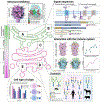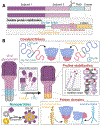Influence of glycosylation on the immunogenicity and antigenicity of viral immunogens
- PMID: 37972669
- PMCID: PMC10867814
- DOI: 10.1016/j.biotechadv.2023.108283
Influence of glycosylation on the immunogenicity and antigenicity of viral immunogens
Abstract
A key aspect of successful viral vaccine design is the elicitation of neutralizing antibodies targeting viral attachment and fusion glycoproteins that embellish viral particles. This observation has catalyzed the development of numerous viral glycoprotein mimetics as vaccines. Glycans can dominate the surface of viral glycoproteins and as such, the viral glycome can influence the antigenicity and immunogenicity of a candidate vaccine. In one extreme, glycans can form an integral part of epitopes targeted by neutralizing antibodies and are therefore considered to be an important feature of key immunogens within an immunization regimen. In the other extreme, the existence of peptide and bacterially expressed protein vaccines shows that viral glycosylation can be dispensable in some cases. However, native-like glycosylation can indicate native-like protein folding and the presence of conformational epitopes. Furthermore, going beyond native glycan mimicry, in either occupancy of glycosylation sites or the glycan processing state, may offer opportunities for enhancing the immunogenicity and associated protection elicited by an immunogen. Here, we review key determinants of viral glycosylation and how recombinant immunogens can recapitulate these signatures across a range of enveloped viruses, including HIV-1, Ebola virus, SARS-CoV-2, Influenza and Lassa virus. The emerging understanding of immunogen glycosylation and its control will help guide the development of future vaccines in both recombinant protein- and nucleic acid-based vaccine technologies.
Keywords: Glycoprotein; Glycosylation; Immunogen; Vaccine; Virus.
Copyright © 2023 The Authors. Published by Elsevier Inc. All rights reserved.
Conflict of interest statement
Declaration of Competing Interest The authors for the manuscript titled Influence of glycosylation on the immunogenicity and antigenicity of viral immunogens declare no conflicting interests as outlined by Biotechnology Advances.
Figures





Similar articles
-
Closing and Opening Holes in the Glycan Shield of HIV-1 Envelope Glycoprotein SOSIP Trimers Can Redirect the Neutralizing Antibody Response to the Newly Unmasked Epitopes.J Virol. 2019 Feb 5;93(4):e01656-18. doi: 10.1128/JVI.01656-18. Print 2019 Feb 15. J Virol. 2019. PMID: 30487280 Free PMC article.
-
Glycosylation profiling to evaluate glycoprotein immunogens against HIV-1.Expert Rev Proteomics. 2017 Oct;14(10):881-890. doi: 10.1080/14789450.2017.1376658. Epub 2017 Sep 14. Expert Rev Proteomics. 2017. PMID: 28870097 Free PMC article. Review.
-
Changes in Structure and Antigenicity of HIV-1 Env Trimers Resulting from Removal of a Conserved CD4 Binding Site-Proximal Glycan.J Virol. 2016 Sep 29;90(20):9224-36. doi: 10.1128/JVI.01116-16. Print 2016 Oct 15. J Virol. 2016. PMID: 27489265 Free PMC article.
-
Unmasking Stem-Specific Neutralizing Epitopes by Abolishing N-Linked Glycosylation Sites of Influenza Virus Hemagglutinin Proteins for Vaccine Design.J Virol. 2016 Sep 12;90(19):8496-508. doi: 10.1128/JVI.00880-16. Print 2016 Oct 1. J Virol. 2016. PMID: 27440889 Free PMC article.
-
Exploitation of glycosylation in enveloped virus pathobiology.Biochim Biophys Acta Gen Subj. 2019 Oct;1863(10):1480-1497. doi: 10.1016/j.bbagen.2019.05.012. Epub 2019 May 20. Biochim Biophys Acta Gen Subj. 2019. PMID: 31121217 Free PMC article. Review.
Cited by
-
Future Sequon Finder - A novel approach for predicting future N-linked glycosylation sequon locations on viral surface proteins.PLoS One. 2025 Aug 14;20(8):e0328174. doi: 10.1371/journal.pone.0328174. eCollection 2025. PLoS One. 2025. PMID: 40811715 Free PMC article.
-
Glycoengineered recombinant alpha1-antitrypsin results in comparable in vitro and in vivo activities to human plasma-derived protein.bioRxiv [Preprint]. 2024 Mar 30:2024.03.27.587088. doi: 10.1101/2024.03.27.587088. bioRxiv. 2024. PMID: 38585818 Free PMC article. Preprint.
-
Biofabrication and biomanufacturing in Ireland and the UK.Biodes Manuf. 2024;7(6):825-856. doi: 10.1007/s42242-024-00316-z. Epub 2024 Oct 23. Biodes Manuf. 2024. PMID: 39650072 Free PMC article. Review.
-
Development of a self-assembling multimeric Bann-RBD fusion protein in Pichia pastoris as a potential COVID-19 vaccine candidate.Sci Rep. 2025 May 27;15(1):18467. doi: 10.1038/s41598-025-01242-5. Sci Rep. 2025. PMID: 40425664 Free PMC article.
-
Variation in structural motifs within SARS-related coronavirus spike proteins.PLoS Pathog. 2024 May 28;20(5):e1012158. doi: 10.1371/journal.ppat.1012158. eCollection 2024 May. PLoS Pathog. 2024. PMID: 38805567 Free PMC article.
References
-
- Agnolon V, Kiseljak D, Wurm MJ, Wurm FM, Foissard C, Gallais F, Wehrle S, Muñoz-Fontela C, Bellanger L, Correia BE, Corradin G, Spertini F, 2020. Designs and Characterization of Subunit Ebola GP Vaccine Candidates: Implications for Immunogenicity. Front. Immunol. 11, 2874. 10.3389/fimmu.2020.586595 - DOI - PMC - PubMed
-
- Allen JD, Chawla H, Samsudin F, Zuzic L, Shivgan AT, Watanabe Y, He W, Callaghan S, Song G, Yong P, Brouwer PJMM, Song Y, Cai Y, Duyvesteyn HMEE, Malinauskas T, Kint J, Pino P, Wurm MJ, Frank M, Chen B, Stuart DI, Sanders RW, Andrabi R, Burton DR, Li S, Bond PJ, Crispin M, 2021. Site-Specific Steric Control of SARS-CoV-2 Spike Glycosylation. Biochemistry 60, 2153–2169. 10.1021/acs.biochem.1c00279 - DOI - PMC - PubMed
Publication types
MeSH terms
Substances
Grants and funding
LinkOut - more resources
Full Text Sources
Medical
Miscellaneous

